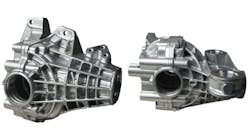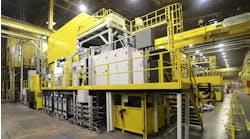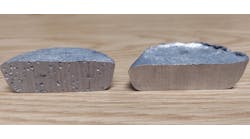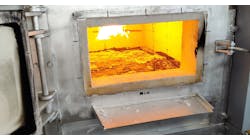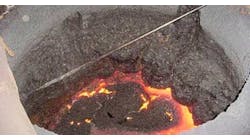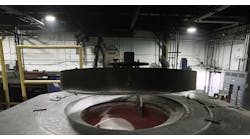Transforming Waste Into Value
Megacasting to Start at Honda
Partnership Boosts Melt Capacity by 30%
Optimizing Aluminum Melt Quality
Diecaster is Rebranding and Investing
Many aluminum foundries spend invest considerable resources controlling the processing operations after the casting is poured, while giving only token attention to what happens prior to pouring. However, it is nearly impossible to solve downstream scrap issues in the foundry without first controlling the melt. The good news is that controlling the melt is not that complicated: Just follow these basic, common-sense foundry practices to help eliminate the aluminum melt as a source of foundry scrap.
Purchased ingots
All aluminum is not created equal. Make sure that the 5 cents per pound saved by using a questionable aluminum supplier is not costing you 50 cents per pound in casting scrap. Quality ingot producers take many steps in the smelting process to ensure the raw material does not contribute to your casting scrap. Your ingot producer should follow these same procedures.
• In-line filters. In the process of pouring ingots, fine ceramic filters are used to remove impurities such as oxides. Without these filters, the impurities will become part the ingot and ultimately the castings, increasing the scrap rate.
• In-line degassing. Quality smelters degas the melt while producing the ingot. When degassing is not performed in ingot production, an incoming ingot will have a much higher quantity of hydrogen gas. This may increase production costs by creating porosity scrap or greatly increasing the required degassing time.
• Chemical control. Chemical variations from lot to lot can significantly affect the mechanical properties of your casting. It is critical that an accurate chemistry certification is supplied with each shipment.
Scrap remelt
Most aluminum foundries re-melt casting scrap. The maximum amount of scrap used for each melt should be controlled. The percentage of scrap allowed should be based on the customer specification of the casting. The larger the percentage of scrap allowed, the greater will be the chance of introducing oxides and other inclusions into the cast part.
In addition to controlling the percentage of scrap remelt allowed, a foundry’s procedures should ensure the quality of the scrap remelt. When remelting scrap, care must be taken to ensure the scrap is dry and clean. In many cases, dross must be removed from the scrap by sawing, grinding, or blasting. Adding scrap to the melt with sand and dross on the surface will result in oxides and inclusions in the casting, increasing the foundry scrap rate and customer reject rate for hard spots and other defects found during machining.
While surface dross can be an issue when remelting scrap castings, most often it is a problem when adding gating to the melt.
Crucible cleanliness
Allowing aluminum and dross to build up on the crucible walls should not be acceptable in any aluminum foundry. This build-up of oxide-saturated material frequently will break loose and release oxide inclusions into the melt, which will end up in the casting and where they cause inclusions and hard spots.
Every aluminum foundry should implement cleaning procedures to ensure the crucible and melt furnace is free of dross build-up.
Ladle cleanliness
The aluminum skin that forms on the walls of a pouring ladle should be removed prior to each pour. The surface of this skin contains an oxide layer that remelts when combined with new molten aluminum. The result is an oxide-rich ladle of molten aluminum that is transferred to the mold and ultimately into the casting.
Degassing
Hydrogen porosity, also known as gas porosity, is small, round, smooth-surfaced internal cavities evenly distributed throughout the aluminum casting. Hydrogen enters molten aluminum via moisture in the air and is always present in the melt.
The extent of the hydrogen content in the melt is affected by many external factors, such as melt temperature, humidity, and raw material. The only way to eliminate hydrogen porosity in the casting is by degassing the melt prior to pouring.
In the degassing process an inert gas, typically nitrogen or argon, is introduced to the melt by use of a rotary degasser or a porous degassing wand. The hydrogen in the molten aluminum will combine with the inert gas bubbles and float to the top of the melt, where it burns off. In order to determine if enough of the hydrogen has been removed to eliminate porosity in the part, a Reduced Pressure Test (RPT) is performed on the molten aluminum prior to pouring.
In the past, an RPT sample was analyzed by manually sawing, polishing, and visually comparing it to a chart. Today, equipment like the Palmer PAS3000 and PAS5000 have vastly improved the accuracy and speed of the RPT. Using this type of equipment reduces the time to analyze the sample to about 30 seconds, with no sawing, polishing, or judgement calls required.
Melt temperature control
Controlling pour temperature is critical to reducing variation in the casting process and reducing casting scrap. Foundry procedures should specify a pour temperature for each casting produced, and ensure that this process control is strictly followed.
The viscosity of the aluminum melt changes with temperature. As the aluminum viscosity changes, the flow of the metal within the mold changes along with the rate at which solidification occurs. Many casting defects, such as oxides, cold shut, hot tear, shrinkage, misrun, penetration, and blow holes are influenced by metal flow and solidification rate.
Brad Hohenstein is the President of Porosity Solutions LLC, and an instructor with The Foundry Way Learning Center.

